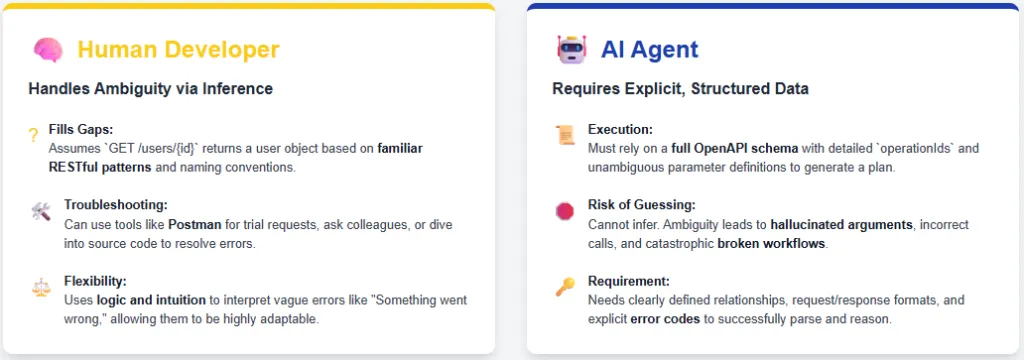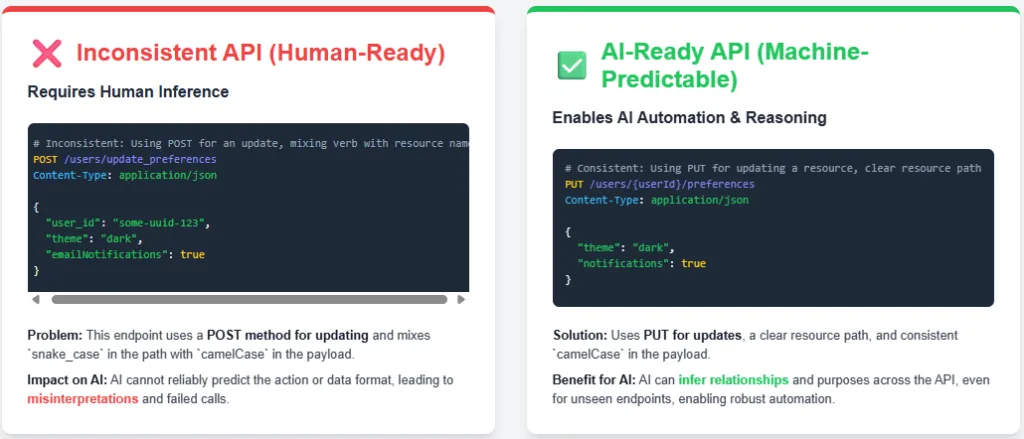Postman not too long ago launched a complete guidelines and developer information for constructing AI-ready APIs, highlighting a easy fact: even probably the most highly effective AI fashions are solely pretty much as good as the information they obtain—and that information comes by means of your APIs. In case your endpoints are inconsistent, unclear, or unreliable, fashions waste time fixing unhealthy inputs as a substitute of manufacturing perception. Postman’s playbook distills years of greatest practices into sensible steps that assist groups make their APIs predictable, machine-readable, and reliable for AI workloads.
This text summarizes the important thing concepts from that playbook. As we transfer right into a world the place Brokers—not people—will make purchases, evaluate choices, and work together with companies, APIs should evolve. In contrast to builders, Brokers can’t compensate for messy docs or ambiguous conduct. They depend on standardized patterns and mechanically generated, machine-consumable documentation that stays in sync along with your schema. The purpose is easy: create APIs that people and AI brokers can perceive immediately, so your programs can scale smarter and unlock their full potential.
Machine consumable metadata
People can infer lacking particulars from imprecise API docs, however AI brokers can’t—they rely totally on specific, machine-readable metadata. As a substitute of claiming “this endpoint returns consumer preferences,” an AI-ready API should outline every little thing: request sort, parameter schema, response construction, and object definitions. Clear metadata like the instance above removes ambiguity, ensures brokers don’t guess, and makes APIs totally comprehensible to machines.



Wealthy Error Semantics
Builders can interpret imprecise errors like “One thing went fallacious,” however AI brokers can’t—they want exact, structured steering. AI-ready APIs should clearly spell out what failed, why it failed, and repair it. Wealthy error metadata with fields like code, message, anticipated, and acquired removes guesswork and allows brokers to self-correct as a substitute of getting caught.


Introspection Capabilities
For APIs to be AI-ready, they need to transfer past human-centric, imprecise documentation. In contrast to builders who can infer lacking particulars utilizing context and RESTful conventions, AI brokers rely totally on structured information for planning and execution. This implies APIs should present full introspection by means of a full schema, explicitly defining all endpoints, parameters, information schemas, and error codes. With out this readability, AI programs are pressured to guess, which inevitably results in damaged workflows and unreliable, hallucinated conduct.


Constant Naming Patterns
AI programs depend on constant patterns, so predictable naming conventions make your API far simpler for them to grasp and navigate. When endpoints and fields observe clear, uniform constructions—like correct REST strategies and constant casing—AI can infer relationships and behaviors with out guesswork. This reduces ambiguity and allows extra correct automation, reasoning, and integration throughout your complete API.


Predictable behaviour
AI brokers want strict consistency—identical inputs ought to all the time produce the identical construction, format, and fields. People can troubleshoot inconsistent responses utilizing instinct, however AI can’t assume or examine; it solely learns from the patterns you present. If naming, nesting, or errors fluctuate throughout endpoints, the agent turns into unreliable or breaks totally. To be AI-ready, your API should implement predictable responses, uniform naming, constant error dealing with, and nil hidden edge circumstances. In brief: inconsistent inputs result in inconsistent agent conduct.


Correct documentation
People can look issues up when docs are unclear, however AI brokers can’t—they solely know what your API explicitly tells them. With out clear, full documentation, an agent can’t uncover endpoints, perceive parameters, predict responses, or get better from errors. Good documentation isn’t non-obligatory for AI-ready APIs—it’s the one means brokers can be taught and reliably work together along with your system.
Dependable and quick
AI brokers act as orchestrators, making fast and sometimes parallel API calls—so your API’s pace and reliability immediately impression their efficiency. People can wait out sluggish responses or retry manually, however brokers will day out, fail, or break complete workflows. In quick, automated environments, an AI system is barely as robust because the APIs it depends on. In case your API can’t sustain, neither can your AI.
Discoverability
People can observe down lacking APIs by means of wikis, chats, code, or instinct—however AI brokers can’t. If an API isn’t clearly printed with structured, searchable metadata, it merely doesn’t exist to them. AI programs depend upon standardized, discoverable specs and examples to grasp use an API. Making your API seen, accessible, and well-indexed—by means of platforms just like the Postman API Community—ensures each builders and brokers can reliably discover and combine it.

I’m a Civil Engineering Graduate (2022) from Jamia Millia Islamia, New Delhi, and I’ve a eager curiosity in Knowledge Science, particularly Neural Networks and their software in numerous areas.
Elevate your perspective with NextTech Information, the place innovation meets perception.
Uncover the most recent breakthroughs, get unique updates, and join with a worldwide community of future-focused thinkers.
Unlock tomorrow’s developments immediately: learn extra, subscribe to our publication, and grow to be a part of the NextTech neighborhood at NextTech-news.com

